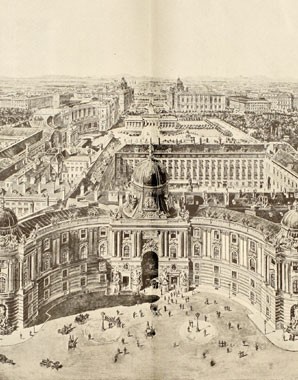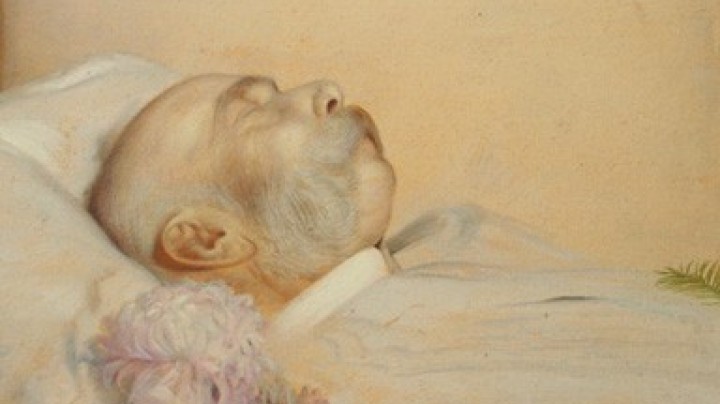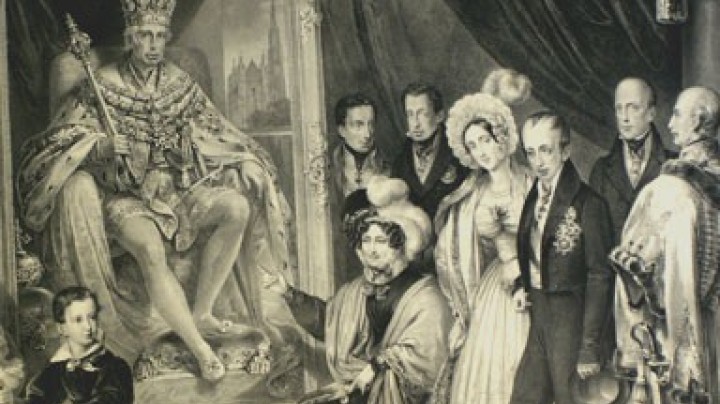The Presidential Chancellery and the long shadow of the double eagle
Even after the end of the Monarchy, Austria’s imperial past remained present: in the Vienna Hofburg the Republic possesses an impressive testimony to Habsburg dominion, a heritage that evokes mixed feelings in many Austrians. Today, where once their Imperial Majesties resided the Federal President of Austria performs his official duties.
Quoted from Marcus Langer: ‘Die Präsidentschaftskanzlei im Leopoldinischen Trakt der Wiener Hofburg’ In: Richard Kurdiovsky (ed.): Die österreichische Präsidentschaftskanzlei in der Wiener Hofburg (Vienna 2008), 120-133, here 123.From a letter written by State Chancellor Karl Renner to Secretary of State Julius Raab on 2 November 1945 concerning the choice of residence for the future Austrian head of state:
In my personal opinion, rooms in the Hofburg would be the most suitable for this purpose, which would undoubtedly be put to appropriate use were the head of state to be accommodated therein.
The Vienna Hofburg was without doubt the most important residence of the Habsburgs in their function as rulers of the Austrian lands, emperors of the Holy Roman Empire and latterly as emperors of Austria. Thus the continuity of its use as the seat of the Austrian Republic’s head of state would seem legitimate.
However, the fledgling Republic of Austria at first thought differently on this matter: given the obvious and prominent emblems and symbols of Habsburg power, which had only just been overcome, there was antipathy to the idea of maintaining the position of the Hofburg as the spiritual centre of a state that was still finding its identity. Thus the federal presidents of the First Republic chose a wing of the Federal Chancellery on Ballhausplatz as their official residence.
The Austria that re-emerged after the Second World War was already more at ease with the country’s monarchical history: its imperial heritage was utilized as a positive counterweight to the tainted National Socialist associations of the immediate past.
As bomb damage had rendered the old presidential chancellery in the Chancellery Office unusable, the provisional State Chancellor, Karl Renner, had to find a suitable place for the official residence of the future federal president and for the presidential chancellery. There were several historic buildings to choose from; the final choice fell on the former Ceremonial Apartments in the Leopoldinischer Trakt of the Hofburg as an appropriate setting for the offices of the head state.
First of all, however, a number of problems had to be overcome: firstly, right of disposal for these premises had to be obtained, as parts of them were being used by the occupying Russian forces. Moreover, alterations undertaken in the National Socialist era in preparation for a ‘palace museum’ had to be removed to restore the rooms to their pre-1938 state. Eventually Renner was elected president and moved into the new presidential chancellery at the end of 1946.
What is without doubt the historically most important suite of rooms in the Hofburg is not publicly accessible as a rule. Then as now, its ceremonial heart is the Reiches Zimmer (Rich Room), once the bedchamber of Maria Theresa, now used by the Republic’s ‘substitute emperor’ for receptions and swearing-in ceremonies.
















